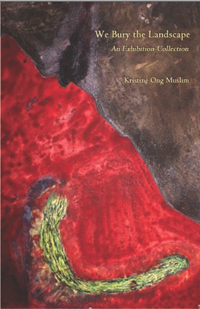 We Bury the Landscape
We Bury the Landscape
by Kristine Ong Muslim
Queen’s Ferry Press, April 2012
168 pages / $12.95 Buy from Queen’s Ferry Press or Amazon
If for one minute, I got lost in the galleries of Kristine Ong Muslim’s mind, I don’t know if I’d ever be able to leave. We Bury the Landscape is a collection of one-hundred ekphrastic works of flash fiction and prose poetry pieces that act as glimpses— better yet— conduits, into parallel universes constructed and inspired by a surreal, but brilliant, forge of one-hundred unique paintings. Visceral is a word that gets overused. But in this case, the text leaps off the pages, claws it ways onto your bones, gnaws and tears and embeds itself inside the cavities of your brain. Many of the stories are short and can be quickly read, but each of them lingers hauntingly as in, “The Taxidermist and the Girl Made of Dead Things:”
It’s a fitting analogy for many of the stories that inhabit the collection. The prose is both blunt and subtle, sometimes making a strategic strike to draw you in, other times, setting up a premise that will be contorted around. “The Village of the Mermaids,” is a good example, starting with a description of Paul Delvaux’s work of the same name:
The women seem harmless enough. But as most great paintings have texture, layers that can be stripped away (both physically and artistically), there are hidden themes that insinuate and dig their way in. These expose not just a tattered moment in dissolute time, but a peep show into the artist in relation to her subject. The curtain gets shredded and Muslim introduces her own twisted slant on the Village:
Every character has a secret, something buried in the landscape. Uncovering the deeper insight, or burying it under more layers, is in many ways the plight of humanity. We struggle for meaning, chase after idols while losing sight of the overall geography. The truth is an admirable goal as long as it’s someone else’s skeletons being revealed. As, “Abandoned Dwellings,” the piece that has the line from which the collection gets its name, explains:
Each of the one-hundred stories is an abandoned dwelling that deserves exploration; that dilapidated shack on the corner as well as the skyscraper crumbling from years of recession, smelling of spray paint, piss, and homeless eclectics. It’s a question of introspection, the honesty to be candid with oneself, to delve into the attics and basements we’d all willingly forget. The darker properties resonated with me personally, but there are happier dwellings in the lot as in, “Rain of Men:”
And one particular line I appreciated in, “What Better Lure,” was:
Many of the stories seem like they could go on, a tantalizing preview to which Muslim invites the reader and then quickly proceeds, an artist in full control of the pace of her show. Any gallery undergoes countless hours of debate, which angles to highlight, which portraits to under-light or flood with electricity. Some of the images are disturbing and had me squirming uncomfortably in my seat. It’s never an easy task to ask to recreate the feeling of writhing anguish. But Muslim gives us that and something more; empathy for the characters she weaves. No matter how horrifying a creation, there’s an air of melancholy, even pity to their actions. The greatest artists and writers are the best psychologists, and each of the profiles contained within the book can be expanded into a journey, epic, bizarre, gleefully strange.
In, “The Collage Artist,” we get an idea for Muslim’s role as curator:
I’m still wandering the gallery of Kristine Ong Muslim’s mind. I just reread the, “Boy With a Propeller Head,” and wish I could fly away with a propeller of my own sticking out of my head. I want to discourse with, “The Great Architect,” based on Salvador Dali’s Surrealist Architecture. The rooms intertwine, a labyrinthine maze of recurring enigmas. I look at the paintings accentuated by centuries of movements, use We Bury the Landscape as guide to navigate. I’m lost, but then again, I’m in no hurry to leave. A painting is sucking me into the canvas. Don’t worry. Just bury me with all the others.
***
Peter Tieryas Liu has stories that have recently appeared in Bartleby Snopes, the Evergreen Review, the Indiana Review, and Punchnel’s. His collection of short stories, Watering Heaven, is coming out in the fall of 2012 from Signal 8 Press. You can follow him at: www.tieryasxu.com
Tags: Kristine Ong Muslim, Peter Tieryas Liu, We Bury the Landscape

:(
[…] Tieryas Liu (and Angela Xu) made this video review adaptation of his review earlier this year of Kristine Ong Muslim’s We Bury the Landscape. Check it […]
[…] http://htmlgiant.com/reviews/we-bury-the-landscape/ […]